非戰爭災難類重大新聞組圖獲獎照片 優秀獎 貧民區里的產婦 孟加拉國-貧民區里的產婦Life: Born in a Slum Sajila is a working mother living in the Korail slum in Dhaka city. She got her husband, mother-in-law and three children (two daughters and a son) in her family. As her husband cannot afford all the m aintenance of the family alone, Sajila works as a day labourer to support him. I began my photo shoot on Sajila when she was four-month pregnant. She lives in a small, suffocating and unhealthy room in the Korail slum. As it is in most of the slums, there is also no doctor or medical service available here in this slum. There are indeed some midwives helping the pregnant mothers in the slum though. But their ability is very much questionable and giving birth to a child under their supervision is unsafe, it even leads the mothers and children to death often. Death-rate at the pregnancy period in Bangladesh is 440 among every 100000; highest in the world. Death rate at child birth is even higher. Since 2007, the rate is 151(either child or the mother) in every thousand. As for the children, the number is 61 per thousand. The reason behind this high death-rate is most of the child-birth in our country is maintained by untrained midwives. Due to economical insolvency and lack of proper medical service, Sajila also decides to give birth to her child under the supervision of a midwife. All her three children have been born this way. Her economical condition was even worse during her pregnancy and she even had to starve for several days. Even though, Sajila did not forget to take advice from the midwife about the dos and don’ts. Finally on the due date, she gives birth to her child under the guidance of that very midwife. Without any modern facilities or medicines, in an unhealthy atmosphere, Sajila have her baby boy delivered normally. It might sound incredible to many, but Sajila walks herself to home with her son only after an hour. 薩吉娜是生活在孟加拉國首都達卡考瑞爾貧民區的一個職業婦女。她的家庭成員有她的丈夫、婆婆和3個兒女(2女1男)。當她的丈夫不能再供養起這個家族時,薩吉娜開始做臨時工來貼補家用。我是在薩吉娜四個月身孕的時候開始記錄拍攝的。她生活在貧民區一間很狹小、憋悶而且很不衛生的房子里。因為絕大多數的貧民區是沒有醫生或其他醫療服務的,所以就有一些產婆來幫助孕婦接生。但是她們的能力令人懷疑,在她們的監護下接生是非常危險的,經常會導致母親和新生兒雙雙斃命。在孟加拉國,孕期死亡率是440:100000,全世界最高。新生兒死亡率更高,自從2007年以來,新生兒和產婦的死亡率是151:1000,光就新生兒來說,是61:1000.這種高死亡率的背后直接原因就是由于沒有專業培訓的產婆接生造成的。由于經濟能力有限,缺乏相應的醫療服務,薩吉娜依然決定由產婆來接生。她的三個孩子都是這樣生下來的。她家的經濟狀況在她懷孕期間變的更糟糕,她甚至到了食不果腹的地步。盡管如此,她仍然沒有忘記提醒產婆一些注意事項。在生產的那天,她就是由這位產婆接生的。在沒有任何現代化的醫療器械和藥物輔助下,在一個非常不衛生的環境中,薩吉娜順利的產下一名男嬰。對于許多人來說,聽上去難以置信,但是薩吉娜在生產完僅一個小時后,就自己抱著孩子走著回到家中。 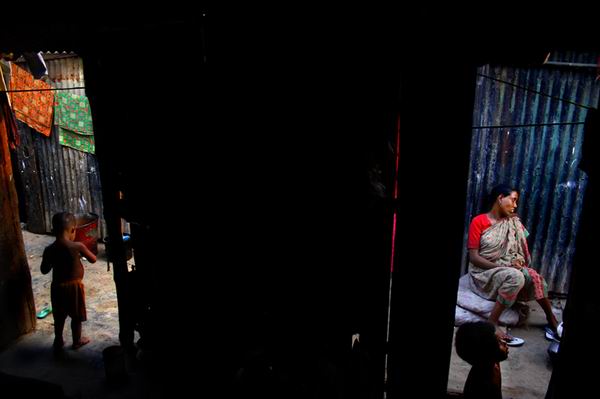
??? 10-01:Sajila (34) a pregnant woman sits amidst the bleak environment of the slum on 24 February 2009, Dhaka, Bangladesh. Sajila is a working mother living in the Korail slum in Dhaka city. She got her husband, mother-in-law and three children (two daughters and a son) in her family. As her husband cannot afford all the maintenance of the family alone, Sajila works as a day labourer to support him. 2009年2月24日,薩吉娜坐在光線昏暗的房間內。

??? 10-02:Sajila (34) is comforting her little son while she herself was tolerating terrible pain on 17 April 2009, Dhaka, Bangladesh.2009年4月17日,身體抱恙的薩吉娜撫慰自己的兒子。

??? 10-03:Even in her pregnancy, Sajila had to do other household works besides her job as a day laborer on 22 March 2009, Dhaka, Bangladesh. Quite understandably, it was not possible for Sajila to have the extra cares or medical support an expecting mother should get. The family will starve if she does not work, so she continues with her heavy work as a day laborer. This was definitely the last thing a pregnant woman should go through.2009年3月22日,有身孕的薩吉娜除了上班外,還要做家務。
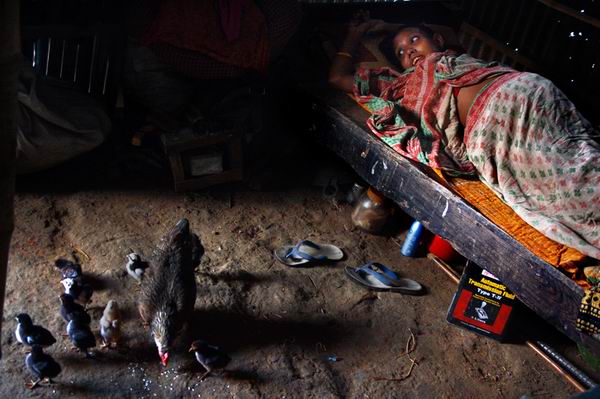
??? 10-04:Sajila is taking rest during idle mid-day on 9 April 2009, Dhaka, Bangladesh. She lives in a small, suffocating and unhealthy room in the Korail slum, which is surrounded by lake. As it is in most of the slums, there is also no doctor or medical service available here in this slum2009年4月9日,薩吉娜在房間內休息。

??? 10-05:The mid-wife is trying to hear the heartbeats of the child with a plastic pipe on 17 April 2009, Dhaka, Bangladesh. Death rate at the pregnancy period in Bangladesh is 440 among every 100000, highest in the world. Death rate at childbirth is even higher. Since 2007, the rate is 151(either child or the mother) in every thousand. As for the children, the number is 61 per thousand. The reason behind this high death rate is most of the child birth in our country is maintained by untrained midwives.2009年4月17日,產婆用塑料管檢查孩子的心跳。
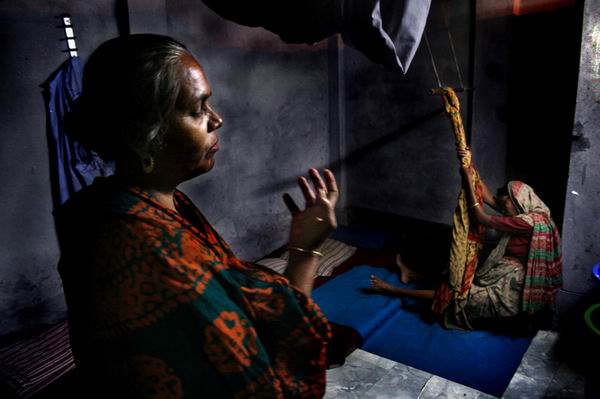
??? 10-06:The process of childbirth is being carried out traditional way on 17 April 2009, Dhaka, Bangladesh. Due to economical insolvency and lack of proper medical service, Sajila also decides to give birth to her child under the supervision of a midwife. Sajila believes, if she has God by her side, she will make it safely, for all her three children have been born this way.2009年4月17日,薩吉娜用傳統方式生產。
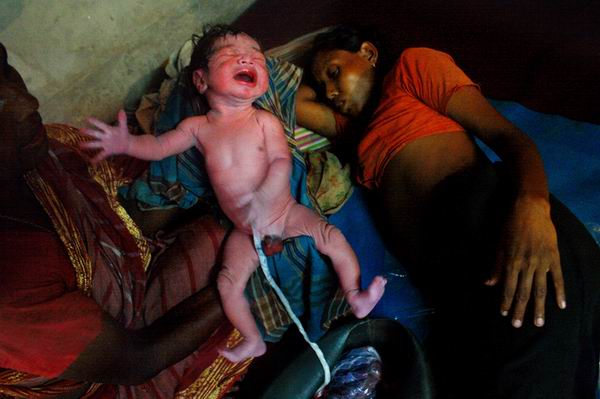
??? 10-07:A new life is born- the mid-wife holds up the boy, Sajila lays beside on 5 May 2009, Dhaka, Bangladesh. Her economical condition was even worse during her pregnancy and she even had to starve for several days. Even though, Sajila did not forget to take advice from the midwife about the dos and don’ts. Finally on the due date, she gives birth to her child under the guidance of that very midwife. Without any modern facilities or medicines, in an unhealthy atmosphere, Sajila have her baby boy delivered normally. It might sound incredible to many, but Sajila walks herself to home with her son only after an hour.2009年5月5日,剛出生的孩子。
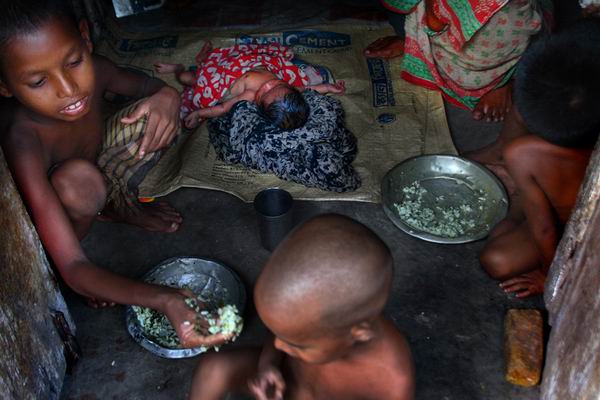
??? 10-08:No special arrangement for the newborn, it is laid down on the floor while Sajila's other three children are having their meal right beside on 8 May 2009, Dhaka, Bangladesh.新生兒誕生的日子與平常無異,其他孩子在一旁吃飯。
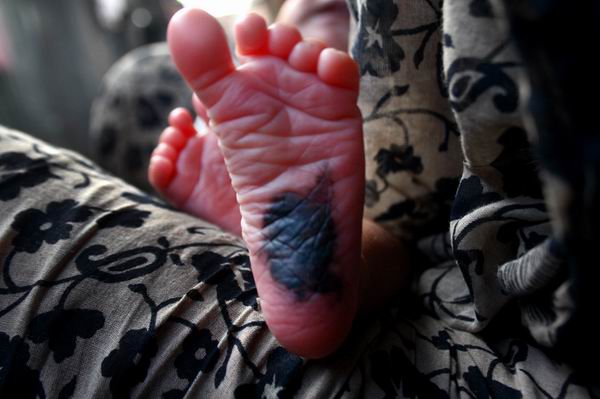
??? 10-09:The boy is being marked Black typo on his leg to ward off evil spirit on 14 May 2009, Dhaka, Bangladesh.2009年5月14日,孩子腳掌被涂上黑色油墨辟邪。
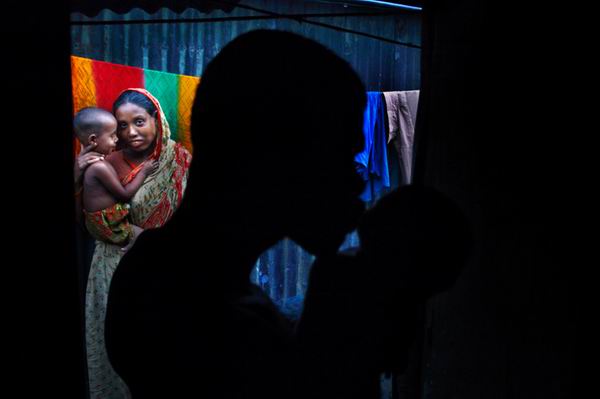
??? 10-10:Even in the backdrop of a grim poverty, the father welcomes the newborn with a kiss. 8 May 2009, Dhaka, Bangladesh.盡管貧窮,孩子的降臨讓家庭充滿歡樂。
|